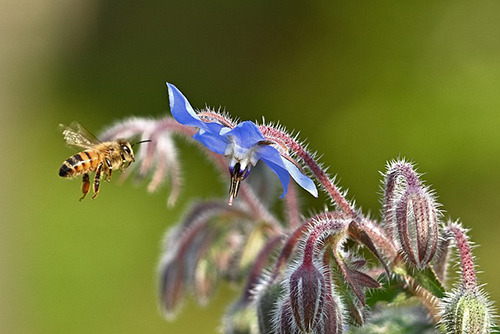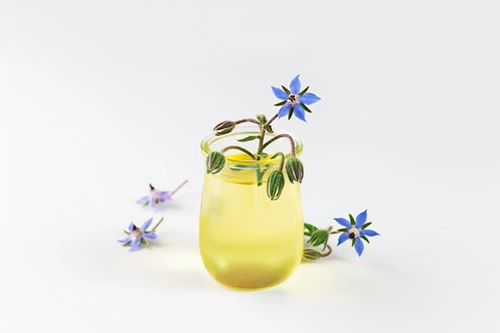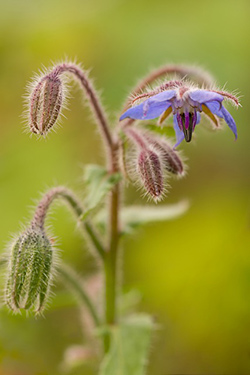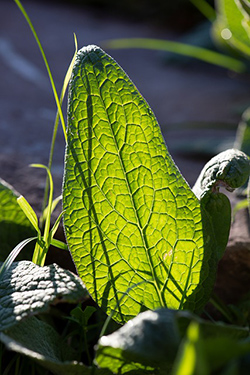Contents
The borage plant comes from the Arabic word abu rash, which means “the father of sweat.” This could be a clue to the solid sudorific properties of its flowers. La Quintinine, the gardener of King Louis the Fourteenth of France, regarded borage as an exquisite vegetable and put it in a unique place in the royal garden, among other depurative plants. Despite that, and maybe because he paid no attention to them, the famous king suffered from diverse ailments: arthritis and gout, among others.
- FORTIFIED BORAGE OIL: Borage Oil is widely-regarded as one of nature’s best sources of enriched GLA
- OPTIMAL ABSORPTION: Delivers 2000 mg of Max GLA Borage Oil in two daily Quick-Release softgels

Healing Properties and Indications
The plant contains many mineral salts, especially potassium nitrate, calcium, and silicon salts. It also contains mucilage and flavonoids. Its more outstanding properties are the following three:

- Sudorific: (mainly its flowers). The borage plant promotes the production of sweat, through which impurities and the metabolic waste flow inside the blood are eliminated. Hence, it is helpful for infectious and fever diseases (measles, chickenpox, scarlet fever, etc.). Since it also has expectorant properties, it is especially recommended for acute bronchitis, bronchial catarrhs, influenza, and colds.
- Diuretic: It increases urine production and eliminates urea, uric acid, and other waste substances. Thus, it is recommended for people suffering from gout, arthritis, or kidney inflammation. The combination of its sudorific and diuretic properties makes the borage plant an excellent blood depurative. The best season to gather and use the leaves in spring when depurative treatments are advisable. We recommend associating it with other depurative plants for a more substantial effect.
- Due to its content of mucilage and prostaglandins, it is emollient and anti-inflammatory (reduces skin and mucosal inflammation). It is externally applied as a poultice to alleviate gout pain and to ripen furuncles and abscesses. Good results are also achieved when applied to eczema and minor burns.
The borage seed oil also has interesting properties such as:
- Hypolipemic: It is rich in linoleic acid (an unsaturated fatty acid). This oil has hypolipemic properties (decreases cholesterol levels in the blood).
- Hormone regulator: Borage seed oil regulates the hormonal system and normalizes the menstrual cycle for menstruation disorders.
Borage Plant Scientific Facts

- French: Bourrache.
- Spanish: Borraja.
- Environment: It is native to North Africa but is cultivated all over Europe and America. In southern Europe, it grows wild in sandy, sunny soils.
- Description: This herbaceous plant of the Boraginaceae family grows from 30 to 70 cm high. The whole plant is covered with a layer of fine white hair. Its flowers are attractive: blue, violet, or white, with five petals.
- Parts of the plant used medicinally: The leaves, the flowers, and the oil of its seeds.
Tasteful vegetable: Borage is regarded as an exquisite vegetable, and with reason. Its leaves can be used raw in salads or cooked with potatoes or other vegetables when tender.
Greater Borage Plant

In Central America, another species of borage (Heliotropicum Indicum L.) is similar in appearance to common borage and is called greater borage. Its composition and properties are very similar to those of borage. Fresh juice is a lotion against itching skin, especially for scabies. The Spanish name for this species is Borrajon.
How to use Borage
- Infusion with 30-40 g of flowers and/or leaves per liter of water. Strain to eliminate the tiny hairs and sweeten with honey if desired. When a sudorific effect is required, use the flowers. Drink from three to five cups daily.
- The fresh juice of the leaves before blooming is a spring depurative. Mash the leaves and strain with a fine cotton cloth or an electric blender. Drink a glass of fresh juice every morning on an empty stomach. It can be combined with the juice of other depurative plants.
- Oil of seeds: These are prepared in pearls or capsules. Take 75-150 mg three times a day.
- Poultices with mashed leaves are applied to the affected areas. The leaves can be raw or blanched in boiling water. In this case, the application must be hot, which will help ripen furuncles and abscesses.
DISCLAIMER: All content on this website is presented solely for educational and informational objectives. Do not rely on the information provided as a replacement for advice, diagnosis, or treatment from a qualified medical expert. If you are pregnant, nursing, or have any preexisting medical concerns, talk to your doctor before using any herbal or natural medicines.
REFERENCES
- George D. Pamplona-Roger, M.D. “Encyclopedia of Medicinal Plants.” George D. Pamplona-Roger, M.D. Encyclopedia of Medicinal Plants. Ed. Francesc X. Gelabert. vols. 2 San Fernando de Henares: Editorial Safeliz, 2000. 746, 747. Print. [borage plant]
- WebMD: https://www.webmd.com/vitamins/ai/ingredientmono-596/borage
- Healthline: https://www.healthline.com/nutrition/borage
- Memorial Sloan Kettering Cancer Center: https://www.mskcc.org/cancer-care/integrative-medicine/herbs/borage
Last update on 2025-06-04 / Affiliate links / Images from Amazon Product Advertising API





